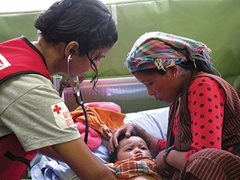Note: This appeal is now closed. You can support our ongoing work by donating to the Canadian Red Cross.
Through the generous support of Canadians, as well as corporate and government donations, over $27.4 million was raised to support this operation.

The earthquake
In April of 2015, Nepal was struck by two massive earthquakes with devastating effects. Approximately 9,000 people lost their lives, 20,000 were injured, and over 600,000 homes were reduced to rubble. In addition, health care facilities were damaged, crops destroyed, and livestock decimated. In the immediate aftermath, millions of people in remote, hard-to-reach communities needed critical help.
Red Cross Response
Emergency Operation
Thanks to the generosity of donors, as well as the Government of Canada, the Canadian Red Cross responded immediately to urgent needs on the ground. Contributions of funds and relief supplies to the Red Cross and Red Crescent Movement’s emergency operation helped reach more than 3 million people with lifesaving assistance, including first aid, clean water, food, tarpaulins, hygiene kits and other relief items.
- 56,250 people received essential healthcare
- 247,839 people received safe water
- 496,724 families (about 2.5 million people) received food
- 360,000 people helped through relief kits containing blankets, tarpaulins, kitchen equipment and a shelter toolkit
- 41,707 families (200,000 people) received cash to help with immediate needs
In the months following the emergency operation, the Red Cross helped thousands of impacted families survive winter through unconditional cash transfers that enabled them to purchase warm clothes and shelter materials.
Emergency Field Hospital
Through generous funding, the Canadian Red Cross also deployed its Emergency Field Hospital and a team of aid workers to the hard-hit community of Dhunche. Red Cross doctors and nurses worked around the clock treating thousands of people in need of care. In the early weeks, mobile clinics also travelled to remote villages to reach people unable to travel to the main field hospital.
- 4-month operation
- 110 aid workers sent to the field hospital (doctors, nurses, technicians)
- 5,406 patients treated
- 31 babies delivered
After several months, the Red Cross team began training Nepalese health workers to take over the operation. In August of 2015, the field hospital was fully transferred to local health authorities. The Red Cross remained on the ground in a training capacity.
Road to recovery
Some of the worst-hit communities in Nepal were those in rural, remote areas. What the earthquake took away in moments will take years to rebuild.
Over the past two years, the Canadian Red Cross and partner Red Cross societies have been working alongside communities across Nepal to help them regain critical access to clean water, sanitation, income, shelter and health care. In doing so, the Red Cross is not only rebuilding communities but also working to strengthen them. That means homes are being rebuilt to withstand a future earthquake; water systems are being reconstructed to bring clean water closer to more families; and farmers are being trained with techniques that make their crops more resilient and their livestock more productive.
In the field of health care, the Canadian Red Cross is strengthening the rural system by providing emergency and trauma care trainings to health care providers. The trainings are being provided in partnership with the Centre for Global Surgery – McGill University Health Centre, the Nepal Red Cross, and local hospitals and medical teaching institutions.
In the village of Dhunche, where the field hospital was first set up, the Canadian Red Cross completed the construction of a health facility to replace the one that was severely damaged in the quake. In addition, equipment from the field hospital is being reused to equip the Nepal Red Cross with its own emergency health clinic. This will enable a mobile health team to be deployed within 24 hours of an emergency, reaching the most remote areas of Nepal. Finally, local health workers from rural areas are being trained and equipped to be able to stabilize patients with serious injuries or trauma.
Red Cross and Red Crescent Movement recovery work to date:
- Health. 15 health facilities and one hospital have been rehabilitated and provided with equipment and medical supplies. 5750 local Red Cross volunteers have also been trained in community health and first aid.
- Shelter. 6,700 households have received cash grants to build earthquake-resistant homes and more than 5,098 masons have been trained to help the rebuilding.
- Water. 220,000 people have regained access to clean water and sanitation facilities.
- Livelihoods. 150,000+ people have received support to regain their source of income.
Donor Updates
3-month donor update
1-year donor update
2-year donor update
3-year donor update
Updated: October 2019